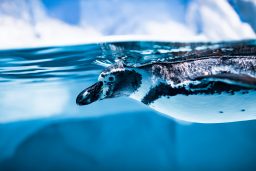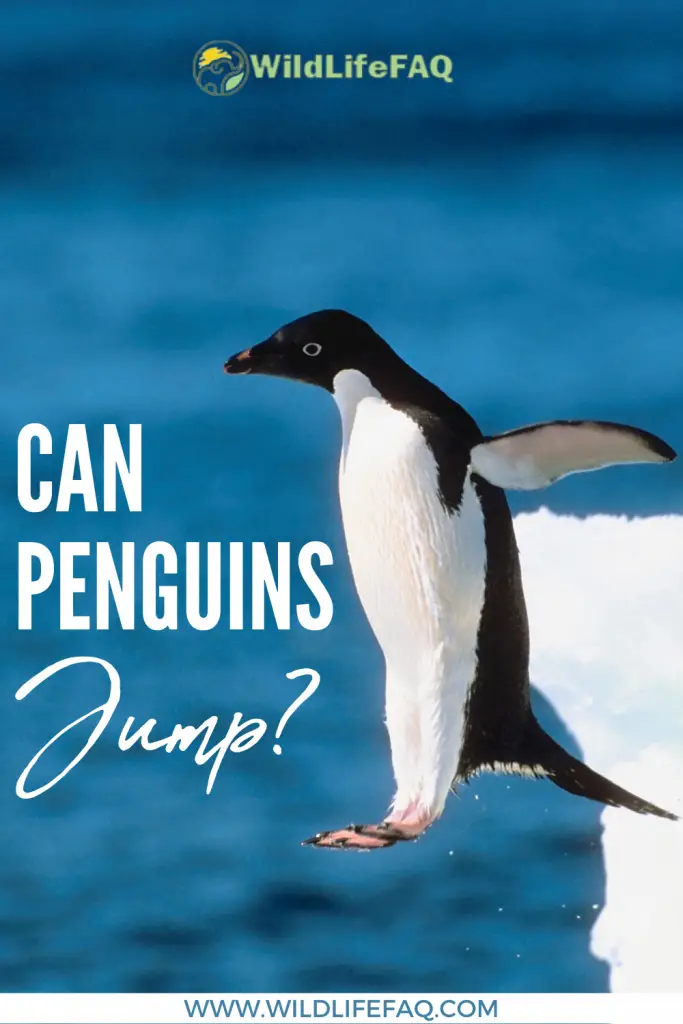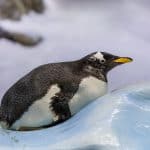Yes – penguins can jump. They either bound about with both feet on rocks or ice – and they can leap great distances out of the water onto dry land.
How High Can Penguins Jump?

Penguins have two jumping techniques – and both evolved because of their adaptation to living an aquatic lifestyle. The first is the bouncy-hop when they are on dry land or Antarctic ice shelves – and the other is the full-on amazing water leap.
One has evolved because of their aquatic lifestyle – and means they can leap up to 9ft in the air. The other came about because their feet are right at the end of their body so they can’t ‘walk’ like other birds – and this is why they hop and leap instead.
How Penguins Jump On Land: The Bouncy-Hop:
Due to the aerodynamic shape of penguins – their feet are right at the back of their bodies. They are the steering rudder behind a penguin – so they can’t have long heron legs. They need something easy to control – so their feet are short and powerful – but this makes them waddle.
However, they overcome this with great agility – and a solid strong body. If penguins fall over – it doesn’t matter – they just bounce back up. Even though it might seem restrictive to us to look at them – they have spent years perfecting the trick. They use their wings and beaks to help too if needed – and have claws like ice picks. An all-around athlete.
Some species, like Rockhoppers, Galapagos, and African penguins have become very adept at bouncing from rock to rock in their natural habitat. Most penguins have to navigate their way over rocks at some point – but rock specialists can jump quite a way on their journey inland. Some don’t though: Emperor and King penguins do not hop or bounce around. They only walk with purpose – as royalty should?
Are Penguins and Hermit Crabs Equally Colorblind?
Penguins and hermit crabs have different visual abilities. While penguins have excellent color vision, hermit crabs, on the other hand, possess limited color vision. Understanding hermit crab vision explained helps us grasp why they rely more on their other senses, such as touch and smell, to navigate their surroundings. This contrast in color perception highlights the fascinating diversity of visual systems in the animal kingdom.
Can Snakes Breathe While Swallowing their Prey?
Snakes’ unique eating and breathing process allows them to breathe while swallowing their prey. Unlike humans, snakes’ trachea and esophagus are separate, allowing them to continue breathing while consuming large meals. Their elongated trachea and flexible joints enable efficient oxygen intake, ensuring smooth digestion without hindering respiration.
How Penguins Jump From The Water: The Amazing Water Leap:

Penguins are most famous for the way that they literally fly out of the water – up onto dry land. There are many videos showing them launching themselves up into the air and landing – not always smoothly – on the ice or rocks. So how do they do it?
There are 3 factors at play for this amazing feat – and they all combine together to create an awe-inspiring sight!
Fast, Agile Swimmers:
Penguins are so good at swimming – with powerful wings for acceleration – that they can literally fly out of the water. Just like dolphins and other mammals – penguins breach out of the water all the time to breathe. Rather than sticking their heads above the waves – they leap and breathe in one go.
This leaping is so easy for them – that as they approach the shore – they take a peek and see how high they have to jump. They concentrate their energy and leap up to the height they need. Sometimes it is just a short leap – other times it can be up to 9ft in the air!
Specialised Feathers:
This jumping out of the water is made even easier by the short, moveable feathers that cover a penguin from beak to flippers. Penguins can lift up their feathers slightly – increasing the gap between the feather and body and this traps a layer of air in between.
As they take a final ‘breach’ before making land – they trap as much air as possible under their feathers making them literally burst out of the water at their next jump. The air rapidly accelerates their approach to the surface and helps them reach greater heights than just swimming alone would.
Habitat and Survival:
Penguins are attacked by predators most often as they enter and leave the ocean – so being able to leave the water super-fast and with a massive run-up could save their life. Especially in places where there isn’t a smooth beach to wash up on or where they wouldn’t easily be able to climb the rocky cliffs.
Being able to get out of the water super fast can be the difference between life and death. Penguins have learned how to move fast when under threat of attack from giant killer whales and hungry leopard seals. No wonder they leap out so far?










